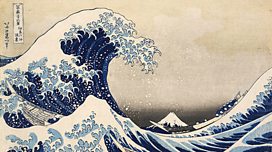Hockney's In the Dull Village
Neil MacGregor's world history as told through objects. Today, a David Hockney print from the height of the sexual revolution.
This week Neil MacGregor's history of the world is examining the forces that helped shape our way of life and ways of thinking today. He began with the political revolution that exploded In Russia in the 1920s and today he moves on to the sexual revolution of the 1960s. He explores the emergence of legally enshrined human rights and the status of sexuality around the world. He tells the story with the aid of a David Hockney print, one of a series that was made in 1966 as the decriminalisation of homosexuality was being planned, at least in Britain. We hear from David Hockney on the spirit of the decade and from Shami Chakrabarti, the director of the human rights group Liberty
Producer: Anthony Denselow
Last on
![]()
Discover more programmes from A History of the World in 100 Objects about art.
About this object
Location: England
Culture: The Modern World
Period: 1966
Material: Paper
Ìý
This etching is from a series created in 1966 by David Hockney to illustrate 14 poems by the Greek poet C. P. Cavafy (1863 - 1933). Cavafy was one of the earliest modern authors to write about same-sex love and proved an inspiration to the young Hockney, who stole a copy of Cavafy's translated poems from Bradford Library in 1960. The etching is not a literal interpretation of the poem's subject matter - homo-erotic fantasies in a sleepy, provincial village - but instead evokes the poem's mood of relaxed intimacy through the use of a crisp and spare line.
How did the Hellenic world inspire Hockney?
Cavafy was born in the cosmopolitan city of Alexandria in Egypt and his poems frequently express same-sex love in the Hellenic world. When Hockney created this print Britain was in the grip of its own sexual revolution - homosexuality was decriminalised by Parliament in 1967. Hockney visited Beirut in Lebanon, which had replaced Alexandria as the region's cosmopolitan capital, to draw inspiration for his series. Many of the illustrations were actually drawn in Hockney's Notting Hill flat, however, using two friends as models.
Did you know?
- Homosexual acts in private were decriminalised in England and Wales in 1967.
Human rights begin in small places
By Shami Chakrabarti, Director of the civil rights organisation Liberty
Ìý
IÌýthink that this is a wonderful image to represent what human rights are all about. As I say it’s a picture of two gay men but it’s not to my eyes desperately erotic or racy or controversial; its two people obviously in some kind of intimate relationship lying next to each other in a relaxed way in bed.
And it reminds me of what Eleanor Roosevelt said about human rights; ‘human rights begin in small places close to home’. This is not big politics, this is not legal judgement and legislation, this is about understanding what it is to be a human being, and respecting it.
I think the image is really important because you can look at it and see a rather sweet, not desperately erotic, but essentially intimate picture of two men lying in bed on a Sunday morning, or something like that, and see it as really quite a sweet image, but I’m sure that there are bigoted people who are still horrified by that idea all over the world, and lest we get too complacent in modern Britain, there are still people who fear deportation from Britain to countries where they might be seriously persecuted, criminalised, imprisoned, or worse. The death penalty, in some cases, just for being themselves – just for perfectly consensual adult feelings and relationships based on love.
'I was rather proud of it at the time'
By David Hockney, artist
Ìý
I think it was Lawrence Durrell published in the back of one of his books a poem by Cavafy, and I’d found Cavafy in the Bradford Library. But you had to ask for it. I looked it up in the index, catalogue, it wasn’t on the shelf because they didn’t want too many people reading these poems, or something, but I got it out. And actually, I never took it back – I kept it. …You couldn’t buy this book in England at the time. And of course the poems were wonderful.
I think I did 12 drawings – 12 etchings – some were drawn from life, some were drawn from my drawings; some were drawn from photographs. I was rather proud of it at the time, and I would have thought of it as good propaganda –…I said that and that’s what some of my work was. Yes, it was, and probably helped a little bit – I don’t know.
…I wasn’t speaking for anybody else but I would certainly defend my way of living…. But if I played a little part of it I’m proud – I might have done, I think, made people open their lives a bit. I’d like to think that.
Transcript
Broadcasts
- Tue 19 Oct 2010 09:45±«Óãtv Radio 4 FM
- Tue 19 Oct 2010 19:45±«Óãtv Radio 4
- Wed 20 Oct 2010 00:30±«Óãtv Radio 4
- Tue 16 Nov 2021 13:45±«Óãtv Radio 4
Featured in...
![]()
Art—A History of the World in 100 Objects
A History of the World in 100 Objects - objects related to Art.
Podcast
-
![]()
A History of the World in 100 Objects
Director of the British Museum, Neil MacGregor, retells humanity's history through objects





